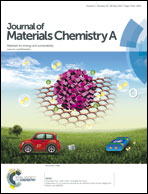Designed synthesis of sulfonated polystyrene/mesoporous silica hollow nanospheres as efficient solid acid catalysts†
Abstract
We report the successful synthesis of hybrid hollow nanospheres (HNs) with sulfonated polystyrene (PS–SO3H) aligned uniformly in the mesoporous channel of a silica shell. The fabrication process involved the sulfonation of silica HNs with polystyrene highly dispersed in the mesoporous shell which was prepared by co-condensation of a mixture of tetraethoxysilane (TEOS) and alkoxysilyl-functionalized poly(methyl acrylate) (PMA) around PS nanospheres in a base medium using cetyltrimethylammonium bromide (CTAB) as structural directing agent followed by THF treatment. The surface properties of the hybrid HNs were adjusted by the amount of PMA incorporated in the silica shell during the synthesis process and also by modification with an octyl group through a grafting method. The hybrid HNs, with acid exchange capacity in the range 0.8 to 2.0 mmol g−1, could efficiently catalyze the esterification reaction of lauric acidwith ethanol. All hybrid HNs show much higher activity than commercial Amberlyst®-15 catalyst and the TOF of the optimized hybrid HNs is almost identical to that of concentrated sulfuric acid. The high activity of the hybrid HNs is mainly attributed to the uniform distribution of the PS–SO3H group in the mesoporous silica shell, the penetrating mesopore, and surface hydrophobicity. It was found that the recycle stability of hybrid HNs could be enhanced greatly by octyl group modification, which may prevent the leaching of PS–SO3H during the catalytic process.


 Please wait while we load your content...
Please wait while we load your content...